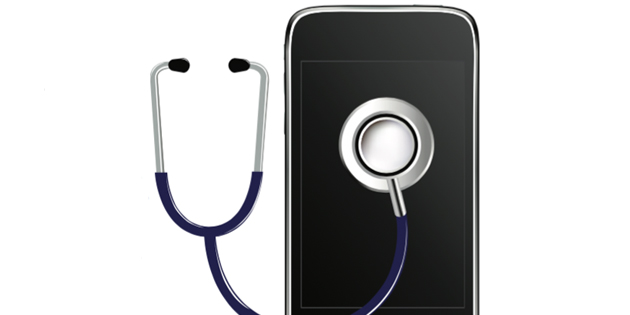 More than 60% of smartphone users used their mobile device to search for information about a health condition, according to Pew Research Center. The analysts at eMarketer have forecast that pharma digital ad spending will rise to $2.55 billion by 2019.
More than 60% of smartphone users used their mobile device to search for information about a health condition, according to Pew Research Center. The analysts at eMarketer have forecast that pharma digital ad spending will rise to $2.55 billion by 2019.
This growing evolution in digital applications to monitor and improve health sets the foundation for new strategies in pharma marketing. Both physicians and patients are heavy users of mobile, and a new challenge arises when the industry shifts its focus to messaging targeting patients. Marketers now need to learn how to create a meaningful digital experience for patient-consumers.
The growth in mobile investment within the industry is real. For example, half of Takeda’s Web traffic last year came from smartphones and tablets, which is why the drug maker is optimizing mobile for both patients and physicians in its marketing campaigns.
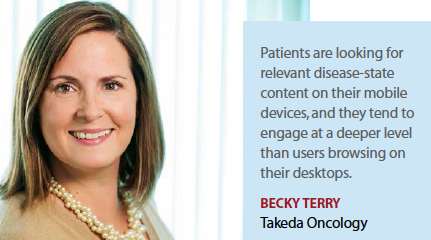 “The influence of mobile is growing across the board and it is becoming increasingly more important to think through the digital experiences users are having in each of the marketing channels," says Becky Terry, senior product manager, U.S. patient marketing, Takeda Oncology.
“The influence of mobile is growing across the board and it is becoming increasingly more important to think through the digital experiences users are having in each of the marketing channels," says Becky Terry, senior product manager, U.S. patient marketing, Takeda Oncology.
For its focus on patients, Takeda recently partnered on a project with WebMD to establish a Velcade-sponsored multiple myeloma education center that includes a mobile-specific microsite with dedicated content featuring Velcade display ads.
During the campaign, Takeda closely monitored the aggregate engagement of mobile users with the center’s content and with the content of its brand’s site, once the users moved from WebMD’s resource center to Velcade.com. According to Takeda, patients using mobile devices viewed on average 55% more pages and spent 20% more time viewing the center’s content than desktop users.
“This validated our belief that patients are looking for relevant disease-state content on the go and, provided the mobile experience is optimized for their devices, they may engage at a deeper level than users browsing on their desktops," Ms. Terry says. “Ensuring that the brand content considered key for patients is easily accessible and loads quickly on mobile devices will help marketers run an effective and seamless marketing campaign that will also further the brand."
Takeda has also experienced an 18% increase in engagement rates with paid search ads that were targeted to mobile users. These findings underscore the importance of marketing to mobile users, and pharma marketers need to make sure that their mobile experience on a brand’s site is optimal, she says.
Mobile Capabilities Enhance Patient Engagement and Adherence
According to our experts, the stakes in mobile marketing have never been higher. Almost two-thirds of Americans own smartphones, and for many, it’s their main communication channel. Across all socio-demographic segments, people expect to 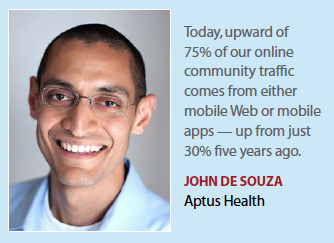 engage in mobile ways, and they expect that it will be a positive, high-value experience.
engage in mobile ways, and they expect that it will be a positive, high-value experience.
“The debate on whether or not to go mobile is over," says John de Souza, president, consumer business, at Aptus Health.
“Today, we have the opportunity to literally be in the pockets of the people we serve — both in those moments when they’re thinking about their health, and perhaps more importantly, in those moments when they’re not, but should be."
“There is so much opportunity to increase engagement with patients through mobile technology," Ms. Terry says. “As patients continue to use online sources to find health information on treatment options, administration, and potential implications, we must continue to develop our sites to be mobile-friendly and make it easier for them to find this information when and where they need it."
Ms. Terry suggests partnering with other organizations to provide education via patient portals that streamline and enhance patients’ understanding of the content. When developing materials, paying attention to what patients are saying they need and looking for ways to be able to provide them with that information in multiple formats are key.
“Patients have specific needs and we aim to integrate a diverse set of solutions — mobile and traditional — to meet these demands as appropriate," she says.
Mobile has a pertinent function in solving the problem of non-adherence of prescription medications, however, many mobile apps can miss the mark with patients.
“Mobile apps in general, and mHealth apps in particular, are legion, but the vast majority fail," says Paul Pierce, VP of development services, Intouch Solutions. “Successful innovation is the aggregate of a lot of little things that achieve two goals: one, creating a value proposition for customers, and two, improving their experience."
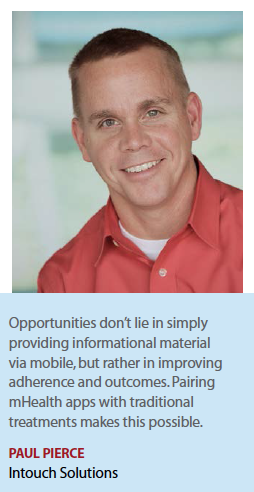 In the pharma environment, there is also a third requirement: meeting the first two goals in a way that complies with FDA guidelines.
In the pharma environment, there is also a third requirement: meeting the first two goals in a way that complies with FDA guidelines.
“The real opportunities don’t lie in simply providing informational material — the app version of brochureware — but in finding simple ways to improve adherence and outcomes," he says. “When mHealth apps are paired with traditional treatments, this becomes possible."
“The at-hand nature of mobile devices is perfectly suited to pharma adherence programs," says Don Feiler, chief technology officer, Calcium.
A well-designed mobile adherence program combining mobile content, appointment reminders, push notifications, prescription refill automation, and disease-state educational materials positions patients for better health outcomes. Add in mobile apps and companion devices that monitor patient health — think Fitbit or Apple Watch — and the result is a mobile-equipped healthcare consumer totally engaged, in partnership with his or her HCP, in his or her health and wellbeing, he says. The win-win is that better adherence translates into improved patient outcomes as well as greater revenue for pharmaceutical companies.
Another advantage for pharma stems from the ability to drive more value with hyper-relevant advertising at scale, which in turn enables patients to get information that better matches their needs at times and in ways they are most likely to receive it, adds Mr. de Souza. When patients have access to credible health information and support anytime and anywhere, they’re more apt to keep their health behaviors top of mind.
Mr. de Souza says 62% of smartphone users use their phones to look up information about a health condition — more than they do online banking, researching or applying to a job, or even finding a place to live.
“For example, at MedHelp people with type 2 diabetes who engage with an app to track their blood glucose levels do so nearly every day — on average 26 times a month," Mr. de Souza says. “This is the kind of health engagement any diabetes care provider would love to see in his or her patients."
Mr. de Souza, one of the founders of MedHelp, reports that five years ago, 30% of the traffic to its site was via a mobile device.
Today, upward of 75% of site traffic comes from either mobile Web or mobile apps, he says.
Although mobile offers an open channel with healthcare consumers, including notifications, reminders, and alerts that help instill better health behaviors, it is important not to overuse the channel with irrelevant interruptions and messages.
“This opportunity comes with the responsibility not to burn this channel and use it to share relevant content that delivers a positive experience," Mr. de Souza says.
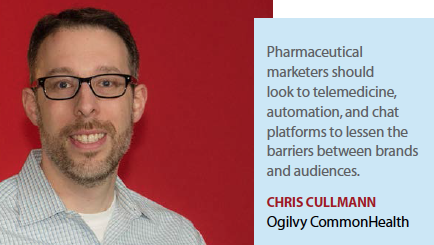 According to Chris Cullmann, senior VP, engagement strategy, Ogilvy CommonHealth, recording health data, capturing information about a condition through photos, video, audio recording, and even providing insurance information tools can create access opportunities for brands to patients and physicians through email, video calls, and chat services.
According to Chris Cullmann, senior VP, engagement strategy, Ogilvy CommonHealth, recording health data, capturing information about a condition through photos, video, audio recording, and even providing insurance information tools can create access opportunities for brands to patients and physicians through email, video calls, and chat services.
“Our phone has become a vessel to document and manage behaviors, and marketers should strive to activate relationships through native tools available on mobile platforms," he says. “Pharmaceutical marketers should look to telemedicine, automation, and chat platforms such as Facebook Messenger to better serve new populations and lessen the barriers between brands and audiences."
Another way to connect with patients is through companion mobile gaming apps.
According to Michael Fergusson, CEO at Ayogo, pharma companies have been using gamification and health games to improve patient engagement for more than five years. For example, in 2010, Healthseeker was the world’s first-of-its-kind game on 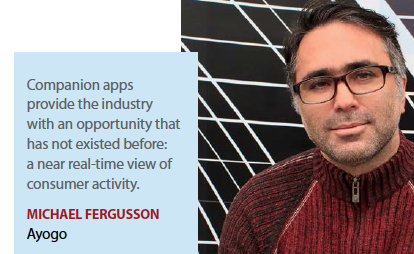 Facebook. Developed by Ayogo in collaboration with the Diabetes Hands Foundation and the Joslin Diabetes and funded by Boehringer Ingelheim Pharmaceuticals, the companion app was designed to motivate better lifestyle choices by people living with diabetes and engage them in improving both their nutritional and physical health. The success of Healthseeker paved the way for other organizations to accept social games as a legitimate part of a patient-centric pharma marketing strategy. Ayogo has been working in the diabetes space with major pharmaceutical companies such as Boehringer Ingelheim, Sanofi UK, Merck, and AstraZeneca.
Facebook. Developed by Ayogo in collaboration with the Diabetes Hands Foundation and the Joslin Diabetes and funded by Boehringer Ingelheim Pharmaceuticals, the companion app was designed to motivate better lifestyle choices by people living with diabetes and engage them in improving both their nutritional and physical health. The success of Healthseeker paved the way for other organizations to accept social games as a legitimate part of a patient-centric pharma marketing strategy. Ayogo has been working in the diabetes space with major pharmaceutical companies such as Boehringer Ingelheim, Sanofi UK, Merck, and AstraZeneca.
“These companion apps provide the pharma industry with an opportunity that’s never existed before: a near-real-time view of consumer activity," Mr. Fergusson says. “We now know that patients are not just non-adherent, but how they are non-adherent, and how their style of non-adherence relates to their engagement with educational and brand materials."
Providing important information and guidance at this emotional crossroad for patients can powerfully impact the outcome.
“Being situated in a place with so much emotional significance for the consumer, we have the opportunity to be influential," Mr.  Fergusson says. “After all, engagement is not at all about efficiency or precision, it is about emotional engagement."
Fergusson says. “After all, engagement is not at all about efficiency or precision, it is about emotional engagement."
He also says being integrated into the consumer’s emotional life is a tremendous opportunity that comes with great responsibility.
Mobile Consumer Analytics Provide Insights
Unlike other industries, pharma has been reluctant to use mobile analytics to drive personalized advertising, because there’s a cost to putting multiple iterations of content through complex regulatory approvals: time, effort, and uncertainty, Mr. Pierce says. One of the drawbacks of this reticence is that it’s led to pharma lagging in analytics overall.
“Analytics make it possible to improve the key function of marketing: presenting the right message to the right audience at the right time," he says. “All brands should collect as much consumer attribution as possible, whether driving personalized content or not, to learn, even anonymously, where patients are in their journey."
Mr. Pierce adds that patients tend to use mobile solutions or tools early in their journey, either at the undiagnosed or newly diagnosed stage. To ensure that brands communicate to patients as powerfully as possible, marketers should rely on creating a communication map that identifies which messages to use on which channels throughout a patient’s journey.
Mr. Cullmann says the highly targeted and analytics-driven model of social media marketing makes it a highly effective and economical channel to reach patients, but pharma has not overwhelmingly taken advantage of the opportunity.
“Despite various regulatory and privacy challenges for healthcare and pharmaceutical brands, there is still a huge opportunity for brands to take advantage of segmentation, behavioral targeting, and retargeting of customers," he says. “Despite growing competition and advances in technology, digital advertising budgets from pharmaceutical brands still lag behind many other categories of industry. A huge opportunity for pharmaceutical brands still remain with social networks as the new advertising platform."
Mr. Feiler understands why the industry has been hesitant to use mobile when targeting patients.
“The use of mobile consumer data is a tricky issue for pharmaceutical marketers," he says. “Sophisticated algorithms in existence today can aggregate and analyze online data points — retail loyalty card data, online browsing habits, e-commerce cart analysis — and pair these with mobile device geolocation data to predict the likelihood of certain disease states. Think type 2 diabetes or osteoarthritis, for instance, in specific households. This level of predictive targeting opens previously unavailable consumer targeting to the pharma industry for disease-state and branded messaging, but pharma companies must proceed with caution. This sophisticated predictive modeling uses blinded data that, technically, must comply with HIPAA guidelines.
Nonetheless, consumers may perceive such granular targeting as a violation of personal health information even if it is not, which may lead to consumer resentment or even — unfounded — complaints to the FDA."
Along with analytics, marketers must also focus on behavioral patterns, Mr. de Souza says.
“Effective advertising is about more than just using consumer mobile analytics to drive results," he says. “It’s about using consumer behavior — with location data being a strong and telling component — to better understand consumers’ needs, and then meet them with the right messaging at the right time."
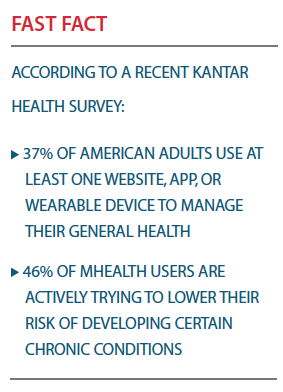 According to Mr. de Souza, recent data suggest that mobile makes up 88% of all “near me" searches and those mobile searches are more than doubling year over year. The most effective mobile campaigns use location, but they don’t stop there. Today’s contextually relevant campaigns must not only understand where people are going in the real world, but also what motivates them to act in those real-world scenarios, in ways they actually appreciate. That means factoring in mobile-based behaviors and other characteristics that influence health decisions such as insurance access, purchasing patterns, demographic and psychographic markers, behavioral indicators, and more.
According to Mr. de Souza, recent data suggest that mobile makes up 88% of all “near me" searches and those mobile searches are more than doubling year over year. The most effective mobile campaigns use location, but they don’t stop there. Today’s contextually relevant campaigns must not only understand where people are going in the real world, but also what motivates them to act in those real-world scenarios, in ways they actually appreciate. That means factoring in mobile-based behaviors and other characteristics that influence health decisions such as insurance access, purchasing patterns, demographic and psychographic markers, behavioral indicators, and more.
For instance, Tomorrow Networks, a division of Aptus Health, enables health and lifestyle marketers to identify audience segments using location-based data combined with other relevant information, such as demographic, condition prevalence, and drug formulary data and reach consumers where they are increasingly spending their time through mobile.
“A marketer can now have access to insights about what consumers buy, where they go, and how likely their household is to respond to a myriad of products," Mr. de Souza says. “This means reaching people based on their real-world activities."
Once the regions with the highest concentration of the client’s target population are identified, messages can be executed through a hyper-targeted point-of-care and ZIP code-level geotargeting campaign to maximize their reach among target consumers.
At Takeda, marketers are using analytical data to learn more about their patient communities, which will ultimately allow them to offer them better educational programs.
“We know that patients are accessing mobile health information throughout their treatment journey," Ms. Terry says. “For instance, half of our Web traffic last year came from smartphones and tablets. To ignore mobile would be to ignore half of the brand’s digital audience."
Marketers need to be fully informed about their consumers in order to make choices around media and search spend. Ms. Terry suggests that marketers constantly evaluate their existing patient-support programs using technology platforms and initiatives like mobile analytics, as data will vary by disease state.
“Some disease states, such as diabetes, are far ahead in the amount of information that is available; in other cases, such as in the more rare diseases, marketers are trying to understand how these patient populations are accessing information," she says.
mHealth Surge Impacts Patient Marketing
The mHealth market is expected to be valued at $26 billion by next year, according to consulting company Research2Guidance.
This growth is shaping the healthcare landscape end to end, and that includes opening new avenues for pharma marketing.
“mHealth provides a huge opportunity for pharma companies to reach consumers in meaningful ways," Mr. de Souza says. “To successfully capitalize on this consumer engagement, pharma marketers need to shift their mindset from one that’s focused on building and delivering campaigns to one that’s focused on building and delivering value to relationships."
This allows brands to move away from trying to acquire new customers every quarter and instead cultivate a long-term relationship with the consumer that’s built around a shared goal of improved condition management.
MedHelp offers condition-specific communities, and within that platform the company brings together data tracking and analytics via wearable devices, condition-specific health content, patient-support communities, and health coaching capabilities into a mobile app or mobile-optimized experience. This creates a single, centralized patient resource for learning, support and better self-management as well as improved communication and data sharing with their healthcare provider. A solution like this has benefits for patients, but it also has benefits for pharma brands as well.
It creates a single location for that brand to reach and educate patients who are highly engaged on a specific condition; it provides trackable interactions to understand a patient’s mindset and their condition management hurdles; and it gives marketers an outlet to help shape the conversation around their brand. This resource helps pharma companies to position themselves for a value-based pricing model, because they understand what really drives value for the patient, Mr. de Souza says.
The time has come for marketers to understand that mHealth has forever changed the marketing environment. Industry must understand that there is a constant evolution happening when it comes to consumers, especially in healthcare. The majority of patients are accessing health and treatment information online and usually half of them are doing so via mobile.
“It is extremely important for marketers to stop thinking that patients are not accessing information through mobile," says Ms. Terry. “This is an old mindset that simply isn’t true."
Marketers need to provide the right education to patients where they are in their treatment journey, which is often on their smartphone. Timing is everything and when a patient is looking for information it’s important to not only provide it but to make it easily accessible through mobile platforms. Developing websites that are responsive and mobile friendly will increase engagement and heighten the impact that mobile platforms have on the user experience, she says.
“The advent of mHealth represents the opportunity for pharma to use nontraditional new paths to meet marketing goals: increasing awareness and loyalty," Mr. Pierce says. “The importance of mobile isn’t the technology, it’s the user experience. Mobile is simply where consumers are today."
With blockbusters going off patent, more generic competition, and price pressure from payers and government, reaching customers effectively is more important than ever before, and fortunately, the FDA has recently clarified requirements for mobile apps clearing the way for more opportunities.
“Mobile, more than any other platform before it, is about discovery," Mr. Cullmann says. “Pharmaceutical brands should enthusiastically address this discovery process by integrating with and augmenting popular mobile applications and platforms."
Despite there being an explosion of popularity in mhealth, wearables, and data-producing “Internet of things" health apps, there is little authority or legacy in this space. Pharmaceutical brands can take advantage of this and provide context, clear next steps, and a drive to physicians and other parties who can make information actionable. These moments of “context" created by health apps and other personal data sources are opportunities to educate. By providing information and curation tools, pharmaceutical brands can find a role in shaping patient journeys and bond patients to physicians through evidence.
The mobile age is all about immediacy and user engagement with mhealth apps is no different, mobile users engage with content that meets their immediate needs, Mr. Feiler says.
“For pharma brands, this presents a unique opportunity to deliver messaging and content at the moment a consumer is thinking about and acting on her healthcare and wellness needs," he says. “When carefully crafted and properly planned, mobile marketing affords pharma brands the opportunity to be present at the very moment a consumer makes important healthcare choices." (PV)










